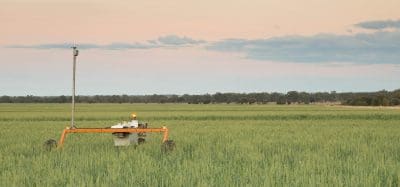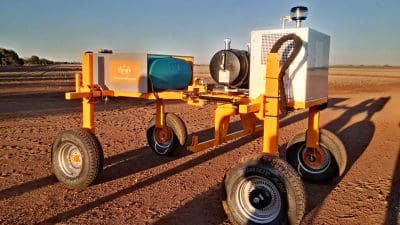AGRICULTURAL robotics is not three or five years away, it is here now, the Precision Agriculture Symposium in Toowoomba, Qld, was told this week.
William McCarthy, a final-year engineering student with the University of Southern Queensland now working with farm-robotic technology innovator SwarmFarm Robotics, told the conference SwarmFarm was pioneering the commercial development of small, automated farming machines to spray crops and, in time, to plant and harvest.
The machines are small, light-weight, collision-avoiding units designed to work in unison across a paddock.
The technology avoids the compaction issues of heavier farm machinery and offers one potential solution to the rural labour shortage.
Where traditional machinery developments are focused on increasing productivity by increasing width or speed to cover hectares per hour, SwarmFarm visualises a completely new farming system, incorporating small, lightweight robots travelling slower, compacting soil less and treating every plant or weed individually.
The units can travel as fast or slowly as required and, unlike a heavy tractor, can stop at individual weeds.
Get our free daily cropping news straight to your inbox – Click here
The machines have been five years in development. Commercial versions of SwarmFarm’s autonomous farming machines could soon be operating in Australian fields.
“Currently at SwarmFarm we have three robots in the field in central Queensland spraying broadacre farms,” Mr McCarthy said.
“Although we are not ready to start selling these robots, we have an aim to have them to early adopters by June next year.”
Safety
The machines have wheel and steering encoders, IMU (inertial measurement unit) and obstacle detection, all designed to prevent the machines running into hazards or crashing. Paddocks are mapped to show fixed obstacles and muddy areas.
The machines are designed, with geofencing, to communicate with each other and not to run outside the paddock.
The person observing the machines could deploy the remote Estop safety stop control, or if the person with the remote Estop was to leave the area, all units would lose their “heartbeat” message and shut down.
Conceptual challenge
Mr McCarthy posed the hypothetical: “Is pushing a seed into the ground with something like a sowing machine a better way of planting? We don’t know yet but robotics will allow us to find out”.
He foreshadowed several other futuristic roles for robotics such as microwave killing of weeds, picking snails off wheat plants and squashing them and cutting excess tillers off wheat plants in a dry year.
The machines of the future will have the autonomous capacity to get fuel and water themselves, and divvy up tasks efficiently between several machines in one paddock.
Downtime on one machine will have the slack picked up by others working in the paddock. Damaged parts be exchanged with a few bolts. Wiring looms simply click on and off.
Sounds like a dream? Well in one way it is. A dream about a new farming system, a dream to travel slower, lighter and let the machines do the work.



HAVE YOUR SAY